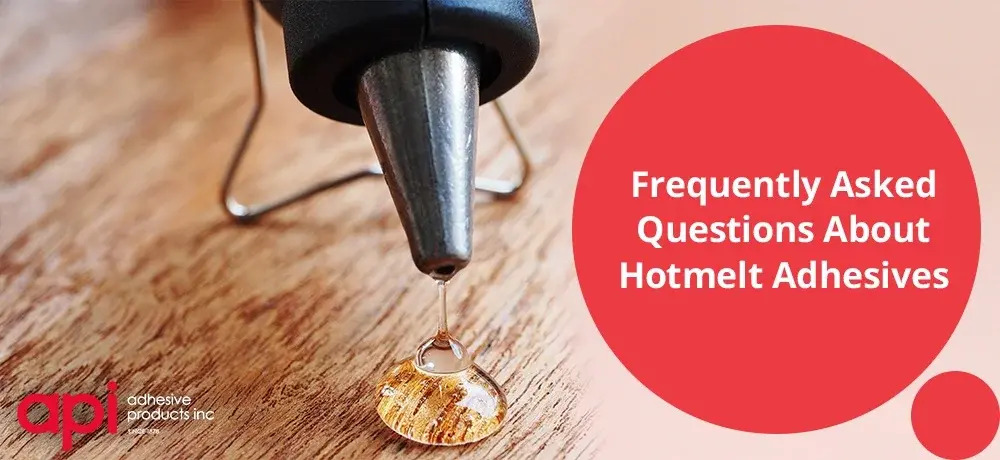Frequently Asked Questions About Hotmelt Adhesives

When it comes to adhesives, there are a ton of questions clients have but often find answers difficult to come by. This lack of information could cause you to use the wrong bonding agent and end up costing you a fortune. To ensure this doesn’t happen, the experts at Adhesive Products Inc. want to arm you with the most accurate information available and have, therefore, put together a list of the most frequently asked questions about hotmelt adhesives.
1. What temperature should I have the glue set to?
Always check your TDS of your particular product, but generally, our hotmelt should be run at 350º F in the glue pot, hoses, and nozzles.
2. Why is the glue stringing, or creating angel hair?
This is caused by the glue being too cold as it leaves the gun. Hotmelt set at too cold a temperature will set up quickly, and will create angel hair. Check your temps, and raise the temperatures on the glue gun and hoses. Also, check the amount of glue you are applying, you could be wasting money by using too much glue.
3. Are their different glues for different papers or plastics?
Yes, please let us know if the substrates you are using are changing, or have certain coatings. It is a good idea to let us know even if you change your paper or box supplier. More and more corrugated boxes are using recycled papers, which shortens the fibers of the paper itself, and makes it more challenging to adhere to. We have worked long and hard to find solutions to these common issues, but we can’t help if we don’t know what may have changed in your production. We are more than happy to do some laydown tests in our lab to ensure you are using the right product. Certain coatings can change the chemical composition of the glue itself, so please let us know what you are using, and we can provide the solution.
4. Why is my glue not working?
Have you checked the temperature settings? Did you change your substrates or suppliers? These are two great ways to start troubleshooting. Glue knows how to do one thing, and very rarely doesn’t do what it is intended for. Keep in mind all the variables.
5. Do you have a glue for cold environments vs. hot environments?
Yes, depending on if you are gluing boxes for cold storage vs. ambient temperature, this will greatly affect the product you need. They generally will not work in both environments.
6. Will more glue help if I am experiencing pop opens?
No. Adding more hotmelt to a flap or a manufactures seam will only increase the drying time of the adhesive, and unless you compensate for this with adding more compression time, you will only make things worse. Check your glue beads. Are you applying too much, or too little? Is the bead still a perfect bead? Check your compression. You may not be squared up with your compression rollers or mandrel.
7. How do I know how much glue to use?
A great way to set your bead is to thin out the glue until you have failures, then slowly increase the amount of glue until you don’t see any more pop opens. That way, you ensure you are not applying too much glue, and you are on track to using less glue and saving money. Less is more.
8. Is Metallocene Hotmelt better than standard EVA hotmelts?
There is a common misconception that water white hotmelts are the best, and you should never go back to old technology. Metallocene or water white hotmelts have great cleaning properties and will save you money on keeping your equipment clean. It will also adhere to specific substrates enduring a wide range of environmental temperatures. So it has great thermal stability. Keep in mind, if you have difficult coatings or substrates, the older technology is still the best. You can still easily maintain your equipment and save money from buying replacement parts by having a healthy PM schedule to clean your machines. The true answer to this question really depends on your application, and in some cases, it is better, in some, it is not. Keeping an open mind and listening to your results are key to success.
If you have any more questions about adhesives, get in touch with the experts at Adhesive Products Inc. As the leading providers of adhesive products in San Francisco, California, we have over 140 years of experience in creating the best adhesives to suit your requirements. We rigorously focus on quality, service, and product development to ensure all your demands are met with quality solutions. To learn more about how we can help you, please click here or contact us by clicking here.